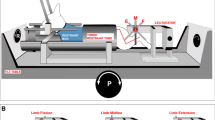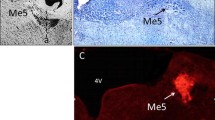Abstract
The spatial organization of vestibulospinal (VS) reflexes, elicited by labyrinthine signals and related to head motion, depends on the direction of body tilt, due to proprioceptive neck afferents acting through the cerebellar anterior vermis. The responses of Purkinje cells located within this region to labyrinthine stimulation are modulated by the head-to-body position. We investigated, in urethane-anesthetized rats, whether a 90° leg-to-trunk displacement modifies the responses of corticocerebellar and vestibular nuclear neurons to the labyrinthine input, which would indicate that VS reflexes are tuned by the leg-to-trunk position. With this aim, unit activity was recorded during “wobble” stimuli that allow evaluating the gain and spatiotemporal properties of neuronal responses. The response gain of corticocerebellar units showed a significant drop in the leg-rotated position with respect to the control one. Following a change in leg position, a proportion of the recorded neurons showed significant changes in the direction and phase of the response vector. In contrast, vestibular nuclear neurons did not show significant modifications in their response gain and direction. Thus, proprioceptive afferents signaling leg-to-trunk position seem to affect the processing of directional labyrinthine signals within the cerebellar cortex.







Similar content being viewed by others
Notes
All the following computations are relative to units recorded on the right side. For left side recorded units, CW and CCW parameters have to be reciprocally exchanged.
References
Roberts TDM. Neurophysiology of Postural Mechanisms. 2nd ed. London: Butterworths; 1978.
Horak FB, MacPherson JM. Postural orientation and equilibrium. In: Rowell LB, Shepherd JT, editors. Handbook of Physiology, Section 12: Exercise: Regulation and Integration of Multiple Systems. New York: Oxford University Press; 1996. p. 255–92.
Welgampola MS, Colebatch JC. Vestibulospinal reflexes: quantitative effects on sensory feedback and postural task. Exp Brain Res. 2001;139:345–53.
Cenciarini M, Peterka R. Stimulus-dependent changes in vestibular contribution to human postural control. J Neurophysiol. 2006;95:2733–50.
Lackner JR, Dizio P, Jeka J, Horak F, Krebs D, Rabin E. Precision contact of the fingertip reduces postural sway of individual with bilateral vestibular loss. Exp Brain Res. 1999;126:459–66.
Igarashi M, Watanabe T, Maxian PM. Dynamic equilibrium in squirrel monkeys after unilateral and bilateral labyrinthectomy. Acta Otolaryngol. 1970;69:247–53.
Roberts TD. Reflex balance. Nature. 1973;244:156–8.
Wilson VJ, Schor RH, Suzuki I, Park BR. Spatial organization of neck and vestibular reflexes acting on the forelimbs of the decerebrate cat. J Neurophysiol. 1986;55:514–26.
Magnus R. Korpestellung. Berlin: Springer; 1928.
Von Holst E, Mittelstaedt H. Das Reafferenzprinzip (Wechselwirkung zwischen zentralnervensystem und peripherie). Naturwissenschaften. 1950;37:464–76.
Lindsay KW, Roberts TD, Rosemberg JR. Asymmetric tonic labyrinth reflexes and their interaction with neck reflexes in decerebrate cat. J Physiol. 1976;261:583–601.
Ezure K, Wilson VJ. Dynamics of the neck-to-forelimb reflexes in the decerebrate cat. J Neurophysiol. 1983;50:688–95.
Manzoni D, Pompeiano O, Srivastava UC, Stampacchia G. Responses of forelimb extensors to sinusoidal stimulation of macular labyrinth and neck receptors. Arch Ital Biol. 1983;121:205–14.
Zafeiriou DI. Primitive reflexes and postural reactions in the neurodevelopmental examination. Pediatr Neurol. 2004;31:1–8.
Lund S, Broberg C. Effects of different head positions on postural sway induced by a reproducible vestibular error signal. Acta Physiol Scand. 1983;117:307–9.
Britton TC, Day BL, Brown P, Rothwell JC, Thompson PD, Marsden CD. Postural electromyographic responses in the arm and leg following galvanic vestibular stimulation in man. Exp Brain Res. 1993;94:143–51.
Nashner LM, Wolfsen P. Influence of head position and proprioceptive cues on short latency postural reflexes evoked by galvanic stimulation of the human labyrinth. Brain Res. 1974;67:255–68.
Fitzpatrick R, Burke D, Gandevia SC. Task-dependent reflex responses and movement illusions evoked by galvanic vestibular stimulation in standing humans. J Physiol. 1994;478:363–72.
Mergner T, Siebold C, Schweigart G, Becker W. Human perception of horizontal trunk and head rotation in space during vestibular and neck stimulation. Exp Brain Res. 1991;85:389–404.
Mergner T, Huber W, Becker W. Vestibular-neck interaction and transformation of sensory coordinates. J Vest Res. 1997;7:347–67.
Peterka RJ. Sensorimotor integration in human postural control. J Neurophysiol. 2002;88:1097–118.
Mergner T, Maurer C, Peterka RJ. A multisensory posture control model of human upright stance. Prog Brain Res. 2003;171:231–50.
Maurer C, Margner T, Peterka RJ. Multisensory control model of human upright stance. Exp Brain Res. 2006;142:189–201.
Manzoni D, Pompeiano O, Andre P. Neck influences on the spatial properties of vestibulospinal reflex in decerebrate cats: role of the cerebellar anterior vermis. J Vest Res. 1998;8:283–97.
Kammermaier S, Kleine J, Buttner U. Vestibular-neck interaction in cerebellar patients. Ann N Y Acad Sci. 2009;1164:394–9.
Wilson VJ, Ezure K, Timerick SJ. Tonic neck reflex on the decerebrate cat: response of spinal interneurons to natural stimulation of neck and vestibular receptors. J Neurophysiol. 1984;51:567–77.
Pompeiano O, Manzoni D, Srivastava UC, Stampacchia G. Convergence and interaction of neck and macular vestibular inputs on reticulospinal neurons. Neuroscience. 1984;12:111–28.
Kubin L, Manzoni D, Pompeiano O. Responses of lateral reticular neurons to convergent neck and macular vestibular inputs. J Neurophysiol. 1981;46:48–64.
Boyle R, Pompeiano O. Convergence and interaction of neck and macular vestibular inputs on vestibulospinal neurons. J Neurophysiol. 1981;45:852–68.
Anastasopoulos D, Mergner T. Canal-neck interaction in vestibular nuclear neurons of the cat. Exp Brain Res. 1982;46:269–80.
Kasper J, Schor RH, Wilson VJ. Response of vestibular neurons to head rotations in vertical planes. II. Response to the neck stimulation and vestibular-neck interaction. J Neurophysiol. 1988;60:1765–78.
Mergner T, Becker W, Deecke L. Canal-neck interaction in vestibular neurons of the cat’s cerebral cortex. Exp Brain Res. 1985;61:94–108.
Denoth F, Margherini PC, Pompeiano O, Stanojevic M. Responses of Purkinje cells of the cerebellar vermis to neck and macular vestibular inputs. Pflugers Arch. 1979;381:87–98.
Manzoni D, Pompeiano O, Bruschini L, Andre P. Neck input modifies the reference frame for coding labyrinthine signals in the cerebellar vermis: a cellular analysis. Neuroscience. 1999;3:1095–107.
Shaikh AG, Meng H, Angelaki DE. Multiple reference frames for motion in the primate cerebellum. J Neurosci. 2004;24:4491–7.
Kleine JF, Guan Y, Kipiani E, Glonti L, Hoshi M, Buttner U. Trunk position influences vestibular responses of fastigial nucleus neurons in the alert monkey. J Neurophysiol. 2004;91:2090–100.
Grasso C, Barresi M, Scattina E, Orsini P, Vignali E, Bruschini L, et al. Tuning of human vestibulospinal reflexes by leg rotation. Hum Mov Sci. 2011;30:296–313.
Pompeiano O. Functional organization of the cerebellar projections to the spinal cord. Progr in Brain Res. 1967;25:282–321.
Barresi M, Bruschini L, Manzoni D. Horizontal rotation of the foreleg modifies vestibular responses of vermal P-cells. Acta Physiol. 2006;188(S652, O10):185.
Pompeiano O, Andre P, Manzoni D. Spatiotemporal response properties of cerebellar Purkinje cells to animal displacement: a population analysis. Neurosci. 1997;81:609–26.
Schor RH, Miller AD, Tomko DL. Responses to head tilt in cat central vestibular neurons. I. Direction of maximum sensitivity. J Neurophysiol. 1984;51:136–46.
Schor RH, Angelaki DE. The algebra of neuronal response vectors. Ann NY Acad Sci. 1992;656:190–204.
Bush GA, Perachio AA, Angelaki DE. Encoding of head acceleration in vestibular neurons. I. Spatiotemporal response properties to linear acceleration. J Neurophysiol. 1993;69:2039–55.
Manzoni D, Andre P, Pompeiano O. Changes in gain and spatiotemporal properties of the vestibulospinal reflex after injection of a GABA-A agonist in the cerebellar anterior vermis. Ves Res. 1997;7:7–20.
Brooks HJ, Cullen KE. Multimodal integration in rostral fastigial nucleus provides an estimate of body movement. J Neurosci. 2009;29:10499–511.
Bruschini L, Andre P, Pompeiano O, Manzoni D. Responses of Purkinje-cells of the cerebellar anterior vermis to stimulation of vestibular and somatosensory receptors. Neuroscience. 2006;142:235–45.
Gundappa-Sulur G, De Schutter E, Bower JM. Ascending granule cell axon: an important component of cerebellar cortical circuitry. J Comp Neurol. 1999;408:580–96.
Llinás R, Sugimori M. Electro-physiological properties of in vitro Purkinje cell dendrites in mammalian cerebellar slices. J Physiol (London). 1980;305:197–213.
D’Angelo E, De Zeuwe CI. Timing plasticity in the cerebellum: focus on the granular layer. Trends Neurosci. 2009;31:30–40.
Coulter JD, Mergner T, Pompeiano O. Effect of static tilt on cervical spinoreticular tract neurons. J Neurophysiol. 1976;39:45–62.
Kubin L, Magherini PC, Manzoni D, Pompeiano O. Responses of lateral reticular nucleus to sinusoidal rotation of neck in the decerebrate cat. Neurosci. 1981;6:1277–90.
Ito M. The Cerebellum and Neural Control. New York: Raven; 1994.
Pompeiano O, Horn E, d’Ascanio P. Locus coeruleus and dorsal pontine reticular influences on the gain of vestibulospinal reflexes. Prog Brain Res. 1991;88:435–62.
Acknowledgments
The present investigation was supported by grants of the Italian Space Agency (ASI, DCMC project and grant I/R/335/02) and of the University of Pisa. We thank M. Vaglini, G. Bresciani, P. Orsini, G. Montanari, and E. Cardaci for their valuable technical assistance and Mr. G. Bertolini for animal care.
Conflict of interest notification page
We declare that none of the authors has financial or personal relationships (consultancies, stock ownership, equity interests, patent-licensing arrangements) that might bias the submitted paper.
Author information
Authors and Affiliations
Corresponding author
Rights and permissions
About this article
Cite this article
Barresi, M., Bruschini, L., Volsi, G.L. et al. Effects of Leg-to-Body Position on the Responses of Rat Cerebellar and Vestibular Nuclear Neurons to Labyrinthine Stimulation. Cerebellum 11, 212–222 (2012). https://doi.org/10.1007/s12311-011-0298-6
Published:
Issue Date:
DOI: https://doi.org/10.1007/s12311-011-0298-6




